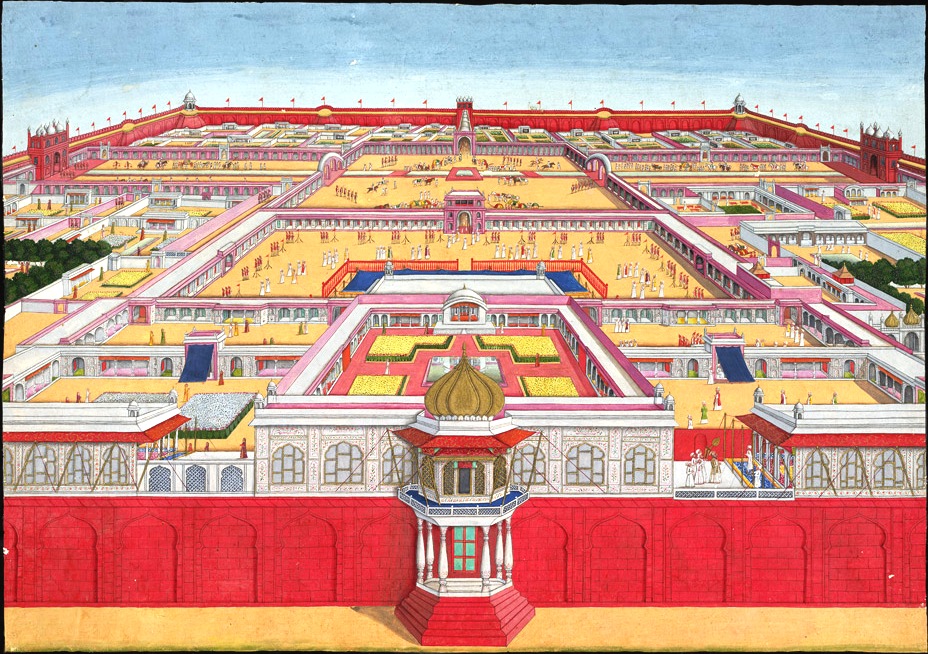|
Satyavijaya Tirtha
Shri Satyavijaya Tirtha (died 1737) () was an Indian Hindu philosopher, guru, and scholar. He was the successor of Satyapurna Tirtha and the 23rd pontiff of Uttaradi Math since Madhvacharya, the chief proponent and the one who rejuvenated this Dvaita philosophy and served the pontificate from 1726–1737. Biography According to hagiographies, Satyavijaya Tirtha was born Pandurangi Balacharya in a prominent family of scholars to Pandurangi Srinivasacharya. Satyavijaya Tirtha was given sanyasa by Satyapurna Tirtha with specific instructions that he, in turn, should hand over the Samsthana to his asrama senior Satyapriya Tirtha. Since Satyavijaya Tirtha was older in age he was given opportunity to be the Pontiff of Uttaradi Math after Satyapurna Tirtha. Satyavijaya Tirtha served as the pontiff of Uttaradi Math from 1726 - 1737. During this time according to manuscripts which dates to 1726 A.D Satyavijaya Tirtha was honoured in Varadharaja Perumal Temple, Kanchipuram with certain ... [...More Info...] [...Related Items...] OR: [Wikipedia] [Google] [Baidu] |
Hinduism
Hinduism () is an Indian religion or ''dharma'', a religious and universal order or way of life by which followers abide. As a religion, it is the world's third-largest, with over 1.2–1.35 billion followers, or 15–16% of the global population, known as Hindus. The word ''Hindu'' is an exonym, and while Hinduism has been called the oldest religion in the world, many practitioners refer to their religion as '' Sanātana Dharma'' ( sa, सनातन धर्म, lit='the Eternal Dharma'), a modern usage, which refers to the idea that its origins lie beyond human history, as revealed in the Hindu texts. Another endonym is ''Vaidika dharma'', the dharma related to the Vedas. Hinduism is a diverse system of thought marked by a range of philosophies and shared concepts, rituals, cosmological systems, pilgrimage sites, and shared textual sources that discuss theology, metaphysics, mythology, Vedic yajna, yoga, agamic rituals, and temple building, among other topi ... [...More Info...] [...Related Items...] OR: [Wikipedia] [Google] [Baidu] |
Madhvacharya
Madhvacharya (; ; CE 1199-1278 or CE 1238–1317), sometimes anglicised as Madhva Acharya, and also known as Purna Prajna () and Ānanda Tīrtha, was an Indian philosopher, theologian and the chief proponent of the '' Dvaita'' (dualism) school of Vedanta. Madhva called his philosophy '' Tattvavāda'' meaning "arguments from a realist viewpoint". Madhvacharya was born on the west coast of Karnataka state in 13th-century India. As a teenager, he became a Sanyasi (monk) joining Brahma-sampradaya guru Achyutapreksha, of the Ekadandi order. Madhva studied the classics of Hindu philosophy, and wrote commentaries on the Principal Upanishads, the '' Bhagavad Gita'' and the Brahma Sutras ('' Prasthanatrayi''), and is credited with thirty seven works in Sanskrit. His writing style was of extreme brevity and condensed expression. His greatest work is considered to be the '' Anuvyakhyana'', a philosophical supplement to his bhasya on the Brahma Sutras composed with a poetic struct ... [...More Info...] [...Related Items...] OR: [Wikipedia] [Google] [Baidu] |
Dvaita Vedanta
Dvaita Vedanta (); (originally known as Tattvavada; IAST:Tattvavāda), is a sub-school in the Vedanta tradition of Hindu philosophy. The term Tattvavada literally means "arguments from a realist viewpoint". The Tattvavada (Dvaita) Vedanta sub-school was founded by the 13th-century philosopher-saint Madhvacharya. Madhvacharya believed in three entities - God, ''jiva'' (soul), and ''jada'' (''maya'', matter). The Dvaita Vedanta school believes that God and the individual souls ( jīvātman) exist as independent realities, and these are distinct, being said that Vishnu (Narayana) is independent (''svatantra''), and souls are dependent (''paratantra'') on him. The Dvaita school contrasts with the other two major sub-schools of Vedanta, the Advaita Vedanta of Adi Shankara which posits nondualism – that ultimate reality ( Brahman) and human soul ( Ātman) are identical and all reality is interconnected oneness, and Vishishtadvaita of Ramanuja which posits qualified nondualism ... [...More Info...] [...Related Items...] OR: [Wikipedia] [Google] [Baidu] |
Madhva Religious Leaders
Madhvacharya (; ; CE 1199-1278 or CE 1238–1317), sometimes anglicised as Madhva Acharya, and also known as Purna Prajna () and Ānanda Tīrtha, was an Indian philosopher, theologian and the chief proponent of the ''Dvaita'' (dualism) school of Vedanta. Madhva called his philosophy '' Tattvavāda'' meaning "arguments from a realist viewpoint". Madhvacharya was born on the west coast of Karnataka state in 13th-century India. As a teenager, he became a Sanyasi (monk) joining Brahma-sampradaya guru Achyutapreksha, of the Ekadandi order. Madhva studied the classics of Hindu philosophy, and wrote commentaries on the Principal Upanishads, the '' Bhagavad Gita'' and the Brahma Sutras (''Prasthanatrayi''), and is credited with thirty seven works in Sanskrit. His writing style was of extreme brevity and condensed expression. His greatest work is considered to be the ''Anuvyakhyana'', a philosophical supplement to his bhasya on the Brahma Sutras composed with a poetic structure. In so ... [...More Info...] [...Related Items...] OR: [Wikipedia] [Google] [Baidu] |
1737 Deaths
Events January–March * January 5 – Spain and the Holy Roman Empire sign instruments of cession at Pontremoli in the Grand Duchy of Tuscany in Italy, with the Empire receiving control of Tuscany and the Grand Duchy of Parma and Piacenza, in return for Don Carlos of Spain being recognized as King of Naples and King of Sicily. * January 9 – The Empires of Austria and Russia enter into a secret military alliance that leads to Austria's disastrous entry into the Russo-Turkish War. * January 18 – In Manila, a peace treaty is signed between Spain's Governor-General of the Philippines, Fernándo Valdés y Tamon, and the Sultan Azim ud-Din I of Sulu, recognizing Azim's authority over the islands of the Sulu Archipelago. * February 20 – France's Foreign Minister, Germain Louis Chauvelin, is dismissed by King Louis XV's Chief Minister, Cardinal André-Hercule de Fleury * February 27 – French scientists Henri-Louis Duhamel du Monceau and G ... [...More Info...] [...Related Items...] OR: [Wikipedia] [Google] [Baidu] |
Kaveri
The Kaveri (also known as Cauvery, the anglicized name) is one of the major Indian rivers flowing through the states of Karnataka and Tamil Nadu. The Kaveri river rises at Talakaveri in the Brahmagiri range in the Western Ghats, Kodagu district of the state of Karnataka, at an elevation of 1,341 m above mean sea level and flows for about 800 km before its outfall into the Bay of Bengal. It reaches the sea in Poompuhar in Mayiladuthurai district. It is the third largest river after Godavari and Krishna in southern India, and the largest in the State of Tamil Nadu, which, on its course, bisects the state into north and south. In ancient Tamil literature, the river was also called Ponni (the golden maid, in reference to the fine silt it deposits). The Kaveri is a sacred river to the people of South India and is worshipped as the Goddess Kaveriamma (Mother Cauvery). It is considered to be among the seven holy rivers of India. It is extensively used for agricultur ... [...More Info...] [...Related Items...] OR: [Wikipedia] [Google] [Baidu] |
Satya Vijaya Nagaram
Satya Vijaya Nagaram (also known as S. V. Nagaram), is a census town in Tiruvanamalai district in the Indian state of Tamil Nadu. The town is named after Satya Vijaya Tirtha, peetadhipathi of Uttaradi Matha whose Moola Brindavana (tomb) is in this town. The town was established by rulers of Arni who were devout followers of Uttaradi Matha and Madhva Sampradaya. Demographics India census A census is the procedure of systematically acquiring, recording and calculating information about the members of a given population. This term is used mostly in connection with national population and housing censuses; other common censuses in ..., Satyavijayanagaram had a population of 5671. Males constitute 50% of the population and females 50%. Sathiyavijayanagaram has an average literacy rate of 68%, higher than the national average of 59.5%: male literacy is 78%, and female literacy is 57%. In Satyavijayanagaram, 12% of the population is under 6 years of age. References Bibliography ... [...More Info...] [...Related Items...] OR: [Wikipedia] [Google] [Baidu] |
Varadharaja Perumal Temple, Kanchipuram
Varadharaja Perumal Temple, also called Hastagiri and Attiyuran, is a Hindu temple dedicated to Vishnu located in the city of Kanchipuram, Tamil Nadu, India. It is one of the Divya Desams, the 108 temples of Vishnu believed to have been visited by the 12 poet saints, or the Alvars. It is located in a suburb of Kanchipuram known as the Vishnu Kanchi that is a home for many famous Vishnu temples. One of the greatest Hindu scholars of Vaishnava Vishishtadvaita philosophy, Ramanuja, is believed to have resided in this temple. The temple along with Ekambareswarar Temple and Kamakshi Amman Temple in Kanchipuram is popularly known as ''Mumurtivasam'' (abode of trio),Rao 2008, p. 154 while Srirangam is referred to as: 'Koil' (meaning: "temple") and Tirupati as: 'Malai' (Meaning: "hill"). Among the Divya Desams, Kanchipuram Varadharaja Perumal temple is known as: 'Perumal Koil'. This is one of the most sacred places for Vaishnavites. The fourth of the Divya Desams that completes this ... [...More Info...] [...Related Items...] OR: [Wikipedia] [Google] [Baidu] |
Vaishnavism
Vaishnavism ( sa, वैष्णवसम्प्रदायः, Vaiṣṇavasampradāyaḥ) is one of the major Hindu denominations along with Shaivism, Shaktism, and Smartism. It is also called Vishnuism since it considers Vishnu as the sole Para Brahman, supreme being leading all other Hindu deities, i.e. ''Mahavishnu''. Its followers are called Vaishnavites or ''Vaishnava''s (), and it includes sub-sects like Krishnaism and Ramaism, which consider Krishna and Rama as the supreme beings respectively. According to a 2010 estimate by Johnson and Grim, Vaishnavism is the largest Hindu sect, constituting about 641 million or 67.6% of Hindus. The ancient emergence of Vaishnavism is unclear, and broadly hypothesized as a History of Hinduism, fusion of various regional non-Vedic religions with Vishnu. A merger of several popular non-Vedic theistic traditions, particularly the Bhagavata cults of Vāsudeva, Vāsudeva-krishna and ''Gopala-Krishna, Gopala-Krishna'', and Narayana, ... [...More Info...] [...Related Items...] OR: [Wikipedia] [Google] [Baidu] |
Sathiyavijayanagaram
Satya Vijaya Nagaram (also known as S. V. Nagaram), is a census town in Tiruvanamalai district in the Indian state of Tamil Nadu. The town is named after Satya Vijaya Tirtha, peetadhipathi of Uttaradi Matha whose Moola Brindavana (tomb) is in this town. The town was established by rulers of Arni who were devout followers of Uttaradi Matha and Madhva Sampradaya. Demographics India census A census is the procedure of systematically acquiring, recording and calculating information about the members of a given population. This term is used mostly in connection with national population and housing censuses; other common censuses in ..., Satyavijayanagaram had a population of 5671. Males constitute 50% of the population and females 50%. Sathiyavijayanagaram has an average literacy rate of 68%, higher than the national average of 59.5%: male literacy is 78%, and female literacy is 57%. In Satyavijayanagaram, 12% of the population is under 6 years of age. References Bibliography ... [...More Info...] [...Related Items...] OR: [Wikipedia] [Google] [Baidu] |
Dvaita
Dvaita Vedanta (); (originally known as Tattvavada; IAST:Tattvavāda), is a sub-school in the Vedanta tradition of Hindu philosophy. The term Tattvavada literally means "arguments from a realist viewpoint". The Tattvavada (Dvaita) Vedanta sub-school was founded by the 13th-century philosopher-saint Madhvacharya. Madhvacharya believed in three entities - God, ''jiva'' (soul), and ''jada'' (''maya'', matter). The Dvaita Vedanta school believes that God and the individual souls ( jīvātman) exist as independent realities, and these are distinct, being said that Vishnu (Narayana) is independent (''svatantra''), and souls are dependent (''paratantra'') on him. The Dvaita school contrasts with the other two major sub-schools of Vedanta, the Advaita Vedanta of Adi Shankara which posits nondualism – that ultimate reality ( Brahman) and human soul ( Ātman) are identical and all reality is interconnected oneness, and Vishishtadvaita of Ramanuja which posits qualified nonduali ... [...More Info...] [...Related Items...] OR: [Wikipedia] [Google] [Baidu] |






